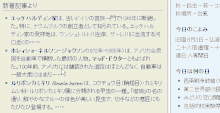Pop up
A pop-up [ ˈpɒpˌʌp ] (from English to pop up , "suddenly appear") is an element of a graphical user interface . Pop-ups are usually used to display additional content or to query a specific interaction. Typically, pop-ups “jump” and cover other parts of the user interface.
species
There are three types of pop-ups in a browser : standalone windows, page built-in elements, and dialog boxes.
Stand-alone windows
Pop-up windows can be opened from one side, but will not close with the window that opened the pop-up window. Most browsers prevent pop-up windows from opening unless they are opened in response to user clicks. Therefore, advertising pop-ups are usually displayed as an additional effect (in addition to opening the actual link) when a link is clicked. The opposite is also possible: the link leads to the advertisement and the desired page is opened in a new window or tab (see pop-under ). This has the disadvantage that the browser's back button no longer works there because no pages were previously opened in the new window or tab.
Dialog box
Dialog windows in the classic sense, which are opened by the browser or another program , are becoming increasingly rare. Dialog windows are windows that are automatically in the foreground and have a text input field or one or more buttons . On the web , however, dialog windows are increasingly being implemented as elements, while ribbons and palette windows are more popular in desktop programs .
element
Pop-up elements are elements within a page , such as lightboxes, which are only available in the frame of the respective page and also disappear when the page is closed.
commitment
Lightboxes
Lightboxes are pop-up elements that contain multimedia objects and are called up by a preview image.
advertising
Unwanted advertising displayed in pop-ups is perceived as annoying by Internet users in particular. Modern browsers usually have pop-up blockers that prevent such pop-up windows from opening. However, this protective measure can be bypassed by the content z. B. in the form of a layer ad , a kind of lightbox for advertising pop-ups, are displayed directly on the original website instead of opening it in a new browser window.
Other uses
In addition, context menus are also pop-up items.
